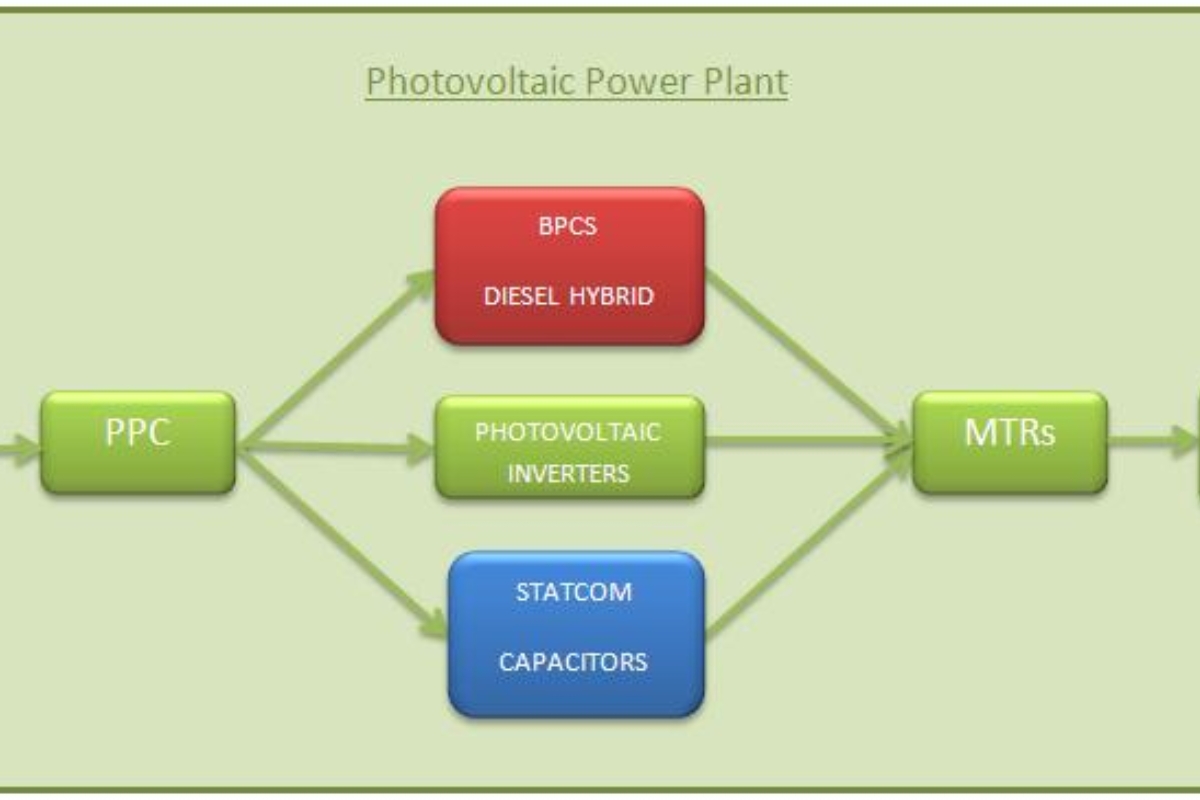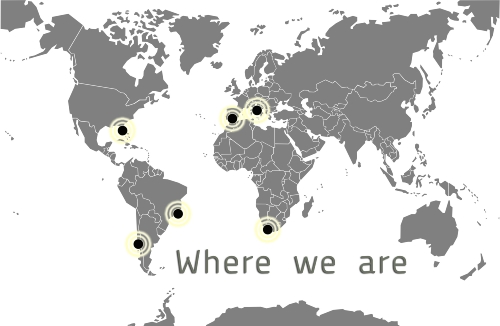Advanced PV plant control strategies for grid integration of PV energy
Authors: Francisco Cortés, Víctor Andrés Díaz and José Ramón Gordillo | Title: Electronic systems control department of GPTech | Published on: Energetica International
The fast growth of renewable energy sources shows its importance for governments and electric companies. Environmental awareness is one of the reasons for supporting renewable energy projects, but there are other reasons from an electric grid management’s point of view.

Increasing the weight of renewable sources in an electric system helps to reduce the dependence on other energy sources that, in most cases, must be imported from other countries. Thus, the development of distributed generation models will play an important role for the renewable energies penetration into the electrical system, but the rising of their contribution in a grid involves that some of their features must be carefully considered.
One of the main drawbacks of renewable energy sources like photovoltaic plants is their unpredictable behavior. Indeed, photovoltaic energy strongly depends on the weather conditions (clouds, temperature, sandstorms, smoke, etc.). These factors may reduce dramatically the power injection into the grid in a very short period of time. For a more efficient management of photovoltaic plants, weather forecasts and statistics may be used, but, unfortunately, they cannot predict such sudden variations. This behavior differs very much from the behavior of conventional synchronous generators because of the different natures of both systems. Mechanisms to control the electric grid parameters, such as frequency or voltage, have been usually developed taking into account conventional generators' dynamics. Therefore, photovoltaic plants should have a similar behavior by means of using the capabilities of their power electronics systems.
Another drawback of the photovoltaic energy is that production peaks, usually, do not match demand peaks so, unless the plant uses an energy storage system, the production excess is wasted. These effects should be carefully controlled, otherwise they may cause grid instability and the benefits of the use of renewable energies may turn into serious troubles.
Typically, photovoltaic plants have had little impact on most electric grids but there are some cases in which the power supplied by a photovoltaic plant may be significant. This is particularly true in islands like, for instance, Puerto Rico (USA), but some other bigger countries are also concerned about the problems of including renewable energy sources and they have started to develop new regulations.
The proceedings of different countries electrical authorities are intended to allow greater penetration of renewable energies based on power electronics (PV Plants) without, thereby, compromising system stability. For this purpose, electrical authorities are demanding control requirements that must be met by the plant in the PCC (Point of Common Coupling) such as:
- Voltage Regulation System
- Power Factor Control
- Reactive Power Control
- Frequency Response
- Active Power Ramp Rate
- Maximum Active Power
Depending on the country, Minimum Technical Requirements (MTR) must consider the additional devices that shall be needed besides PV inverters to meet its MTR for the interconnection to electrical grid. It may be necessary to use energy storage elements such as BESS (Battery Energy Storage System) or diesel generators, as well as elements of reactive power compensation like STATCOMS or capacitor banks. Nowadays, companies such as GPTech are developing PPC (Power Plant Controller) that are achieving these requirements by implementing devices of plant control. The main devices to meet minimum technical requirements (MTRs) are:
- STATCOM: Static Synchronous Compensator
- Capacitors Bank: Reactive Power Source
- BPCS: Battery Power Conditioning System
- Diesel: Diesel Generator
All of them offer different capabilities that need to be managed by a central control unit; in our case, the Power Plant Controller (PPC). The PPC can be understood as a logic device that includes the whole system solution for MTRs.
Voltage Regulation System (VRS): A constant voltage control is required. PPC must have a closed loop control VRS equivalent to the Automatic Voltage Regulator in conventional generators.The VRS controller regulation is based on closed loop actions with parallel reactive droop compensation if required.The VRS set-point must also be adjustable by the operator. Otherwise, constant power factor or fixed reactive power control could be required.
Generally, the voltage control is carried out by photovoltaic inverters reactive capability. VAR compensator devices such STATCOMs or Capacitors Banks provide a source or a sink of reactive power if necessary. Once these issues are considered, the PPC needs to manage the reactive power distribution ratio for each collection:
- Photovoltaic inverters and STATCOMs will receive a continuous external reactive reference. If Capacitors Banks are included, the PPC reactive control shall be able to manage these references and integrate them in output references and the command for the capacitor connection.
- Capacitors Bank will be connected following a defined sequence, so they will give a step in reactive response depending on their capacity.
Frequency Response/Regulation: The facility shall provide an immediate real power primary frequency response, proportional to frequency deviations from scheduled frequency, similar to governor response.
Ramp Rate Control: Ramp Rate Control is required for a smoothly transition from one power output level to another. The PV facility shall be able to control the rate of power output change during some circumstances, including:
- Rate of increase/decrease of solar power due to irradiance
- Rate of increase of power when an external curtailment of power output is released
- Rate of decrease in power when an external curtailment limit is engaged
This ramp rate may apply both to the increase and decrease of power output and is independent of meteorological conditions.
In order to increase the power when the frequency deviation is negative or for ramp control, the PV Plant needs to add an external Energy Storage System. The BPCS introduces the possibility of energy storage. Considering the control algorithms studied before, with BPCS the system is ready to feed or store a specific amount of power at each moment. At this point, the state of charge (SOC) management becomes critical.
The SOC management control will make the SOC value to be within a target band whenever possible. The way to achieve this objective will be to add a ∆P to the reference power that comes from the PPC ramp and frequency control algorithm. So PPC control strategy for SOC management must avoid the following situations:
- If BPCS reaches to SOC maximum, the storage system is only available for feed power.
- If BPCS reaches to SOC minimum, the storage system is only available for storage energy.
Otherwise, the real power control becomes inefficient and the whole system energy production will not meet the optimum point. Although BPCSs seem to be enough for real power MTRs, the system evolution (irradiancy level, frequency instability) may take the SOC to inadequate levels. It is in this point where Diesel generators give a stable source of power, helping to stabilize real power perturbations.
The PPC control strategy for Diesel Generators consists on predictive control for starting the generators at the correct time, so they will be ready to be used when the perturbation occurs. Once these issues are considered, the PPC needs to manage the real power distribution ratio for each collection:
- Photovoltaic inverters will receive the real power saturation to meet curtailment and ramp rate requirement depending on MTRs and BPCS’s management.
- BPCS will receive the real power reference to meet ramp rate and frequency response.
- Diesel Generators will receive real power reference only if BPCS can’t feed power to meet ramp down requirement.
As the Photovoltaic Power Plants are becoming an important element to cover the energy consumption, other elements need to be considered to improve the efficiency and the plant yield. This will be possible by making a better use of the photovoltaic panels, developing accurate tracking algorithms and integrating predictive weather functionality.
Another researching field is focused on batteries. Nowadays, lithium-ion batteries are expensive and have a limited capacity, so a new non toxic, cheap technology with high capacity must be developed before the massive establishment of battery compensation.
The integration of all these elements will take plant control to the next step of control, where all the control strategies will work together to achieve the smart plant concept.



